Earlier this month the WUWT blog treated us to a bizarre post about how this year didn’t set a new record for lowest Arctic sea ice extent (it only came in 2nd-lowest), in spite of “two very strong storms.” Doubling down, they offer another post trumpeting “record Arctic sea ice growth in September.” Which makes me wonder: are those guys trying to make themselves look like idiots?
David Whitehouse (of GWPF. the so-called “Global Warming Policy Foundation”) even uses the phrase “A ten-year hiatus in Arctic ice decline?” I suspect he doesn’t know the meaning of the word “hiatus,” because the graph he shows to support this idea is this one:
It doesn’t look like a hiatus. It sure looks like it has kept going down — because it has.
He even crows about how much CO2 has increased lately, and points to the fact that the decline in the above graph didn’t get even worse! If that’s what you call a “hiatus,” you need a to get your head examined.
It’s also funny that the graph he shows is for each year’s June sea ice extent. Why June? The usual choice is September because that’s when Arctic sea ice reaches its minimum, but the annual average (using all 12 months) might be a better idea. Perhaps he chose June because it doesn’t look like the ice started disappearing faster. It also seems giddy pronouncing that the decline has been only “about 10%.”
His belief in a “hiatus” is based, not on June extent, but on annual minimum extent. But he only shows us 10 years of it:
I think you deserve some context, as in, the whole picture. Here’s the satellite record of annual minimum Arctic sea ice extent:
The red box shows what David Whitehouse shared with his readers. Cherry-picking, anyone?
Then there’s the annual average (rather than annual minimum), which I’ll compute October-through-September so this year will be complete, which looks like this:
If the red line (a lowess smooth) looks like it’s declining faster recently, that’s because it is. And yes, the increased rate of sea ice loss since then is statistically significant. And yes, this last year was the lowest on record.
We can go back even further. Walsh and Chapman combined all available records from meteorological and marine resources, from the U.S., Canada, Russia, Denmark, Great Britain, and more, to estimate sea ice extent since 1850. They came up with this:
I’ll remove the annual cycle to compute anomaly:
Then I can align the Walsh & Chapman anomalies with the satellite data anomalies, giving these annual (January-through-December) averages:
The red box in the lower right (the tiny red box) shows the time span David Whitehouse shared with his readers.
But we can go back even further. A reconstruction of Arctic sea ice by Kinnard et al. covers the last 1450 years, and gives this:

That shows just how unprecedented is the rapid, alarming, surprising, and man-made decline of sea ice in the Arctic. But David Whitehouse wants you to believe it’s nothing unusual.
The loss of Arctic sea ice is so great, so rapid, so alarming and surprising, it’s powerful evidence of dramatic man-made climate change. But folks like the contributors at the WUWT blog, and at the GWPF, keep talking about it in a vain (and rather embarrassing) attempt to downplay it. Their attempts are silly, but what’s probably stupidest is that if they really want to convince people man-made global warming isn’t a problem, they shouldn’t talk about it at all. It’s like being caught with a smoking gun at the scene of a crime, then babbling on and on and on about how you have a gun. And it’s smoking.
This blog is made possible by readers like you; join others by donating at Peaseblossom’s Closet.


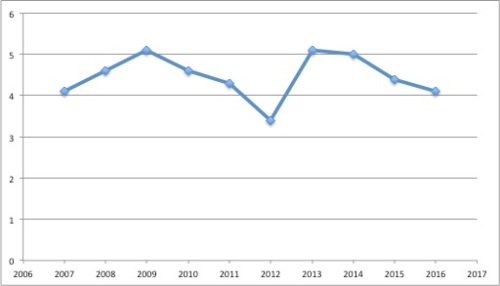
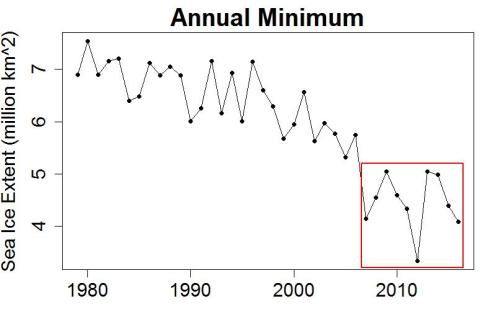
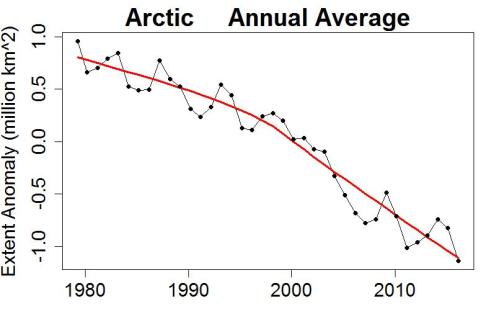

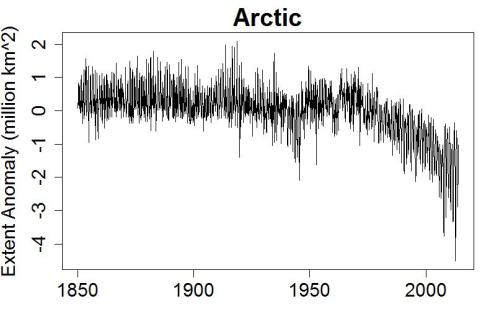
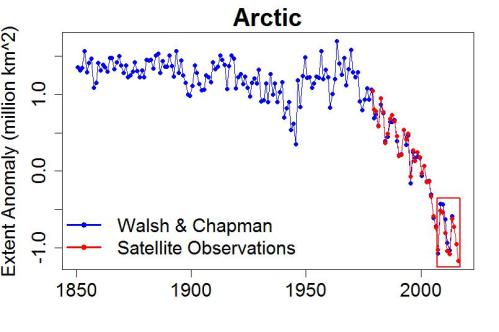


Reblogged this on Don't look now.
In case this is of use to someone

I made an animation of sea ice by year
The r package code is here if anyone wants to roll their own https://gist.github.com/cavedave/c5c2224c8c38661236c1c1ce894fd28f
Nice.
+1
that’s a great graphic – thanks
By some strange coincidence I attempted to bring your work on annual average Arctic sea ice extent to the attention of Mr. Watts and his many merry minions yesterday. Needless to say he was having none of it:
Watts Up With The Inconvenient Arctic Hiatus?
Our title for today does of course refer to the inconvenient hiatus caused by the Gremlins currently stealing my comments from under the noses of Anthony Watts’ eagle eyed team of moderators before they can approve them as suitable for public view.
I guess the old start-at-a-local-min-and-declare-hiatus trick just never gets old for deniers!
I wonder who they think they are fooling?
Again, a very clear and succinct summary. Again, thanks. I’m sure I’ll be pointing to this post.
“Which makes me wonder: are those guys trying to make themselves look like idiots?”
It makes me wonder if they need to try.
Micheal Shermer mentions this phenomena in Merchants of Doubt when he says (and I paraphrase)
“In debates with the “skeptics” I put up graphs showing rising temps, rising sea levels and disappearing ice and then they put the same graphs up and argue the opposite”
By now it should be clear that those bizarro denialists are no longer worth technical attention. Instead they demand serious attention of psychopathologists.
Methinks what we witness is a cultural evolutionary split of hominins into “Homo Sapiens Erectus” (who tries to walk his brains upright) and “Homo Sapiens Fatuus” (the evil clown). The big question is no longer about climate science, but how to get rid of the evil clowns.
Just curious, have you tried to correlate the residual of the annual average to the lowess smooth against climatic variable like ENSO? It looks like there is some structures in these residual with a few years time scale.
Seriously, that’s the graph Whitehouse used to illustrate his claim that Arctic sea ice isn’t in decline??
That’s like telling a police officer you weren’t actually speeding because you were only going 60 over the limit.
Its funny that the deniers don’t talk about how the failure to achieve a new record was not only in spite of some unusually strong storm activity, but also in spite of record warmth and record low volume in winter. It did get unusually cold (in recent terms) at possibly just the right time in the middle of the melt season though.
I do think there is some support in recent data for a slowing of the decline to something like a gompertz, and I think its a shame that denier foolishness distracts from what might be an interesting discussion on whether gompertz or 2nd order polynomial might be a better prediction of the future.
One way or another there is going to be a hiatus in the sea ice decline. Can’t get below 0.
Michael, a number of us have been suggesting for quite a few years that ice extent/volume would follow a logistic, Gompertz, or other sigmoid trajectory, and I suspect that any discussion on the relative merits would quickly turf second order polynomials, if based on physical science! I’d be wary though about equating any recent “slowing” with an indication that the trajectory is following that which occurs when a sigmoid point of inflection is passed and an asymptote is approached: I suspect that any such trend in the recent data is just noise, and several decades hence will with hindsight show that we’re not now yet at the inflection point on the trajectory of the melting of ice.
Bernard – You may be interested to know that Michael & I, together with many others, have been discussing the physical science of which you speak for quite some time:
Arctic sea ice » The Slow Transition
Predictable that the “hiatus” talk would shift to Arctic sea ice after the huge decline during 2006-2012. Surface temperature trends will be off limits for a while now: 10-year trends including 2016 will be +0.3ºC/Decade and all recent trends of various length over 0.14ºC/Decade, even in HadCRUT4. Even UAH won’t be producing negative or near-zero trends any time soon.
The UAH v. 6 anomaly for September is up, and I do mean up–specifically, to 0.44 C. Pretty toasty, especially considering the fading of El Nino.
http://www.drroyspencer.com/latest-global-temperatures/
These guys appear to be consensus scientists:
…Considered in isolation, the reduction in ocean heat transport implies a possible moderation in the rate of Arctic sea ice loss in the coming decade.
Initializing the CM2.1 coupled system produces high skill in retrospectively predicting the mid-1990s shift, which is not captured by the uninitialized forecasts. All the hindcasts initialized in the early 1990s show a warming of the SPG; however, only the ensemble-mean hindcasts initialized in 1995 and 1996 are able to reproduce the observed abrupt warming and the associated decrease and contraction of the SPG. Examination of the physical mechanisms responsible for the successful retrospective predictions indicates that initializing the ocean is key to predicting the mid-1990s warming. The successful initialized forecasts show an increased Atlantic meridional overturning circulation and North Atlantic Current transport, which drive an increased advection of warm saline subtropical waters northward, leading to a westward shift of the subpolar front and, subsequently, a warming and spindown of the SPG. Significant seasonal climate impacts are predicted as the SPG warms, including a reduced sea ice concentration over the Arctic, an enhanced warming over the central United States during summer and fall, and a northward shift of the mean ITCZ. These climate anomalies are similar to those observed during a warm phase of the Atlantic multidecadal oscillation, which is encouraging for future predictions of North Atlantic climate.
I’ve been rather distracted since the UK’s Marching Morons voted for Brexit in late June and blew a hole in both my business and finances. So I haven’t been paying as much attention to sea ice as usual due to lack of time.
However from what I have seen, had we have had the strong Arctic Dipole activity as in 2007 and 2012 we’d likely have smashed those records by a large margin.
Given this winter’s extremely anomalous Arctic warmth it is hard to draw firm conclusions as to the long term decline based on this year. Despite that, I see nothing to change my opinion that we are not in for a fast crash, and that we face a rather slower decline. It still seems to me that we are in the early stages of an inflection due to the winter thickness growth feedback. Whitehouse seems to me to be correct about a new regime, but even in that the idiot can’t get it right because he has the wrong mechanism.
The thickness growth feedback will attenuate the rate of decline, but it cannot stop it. Arctic sea ice is in terminal decline because the forcing agent (AGW) will continue to drive it to extinction.